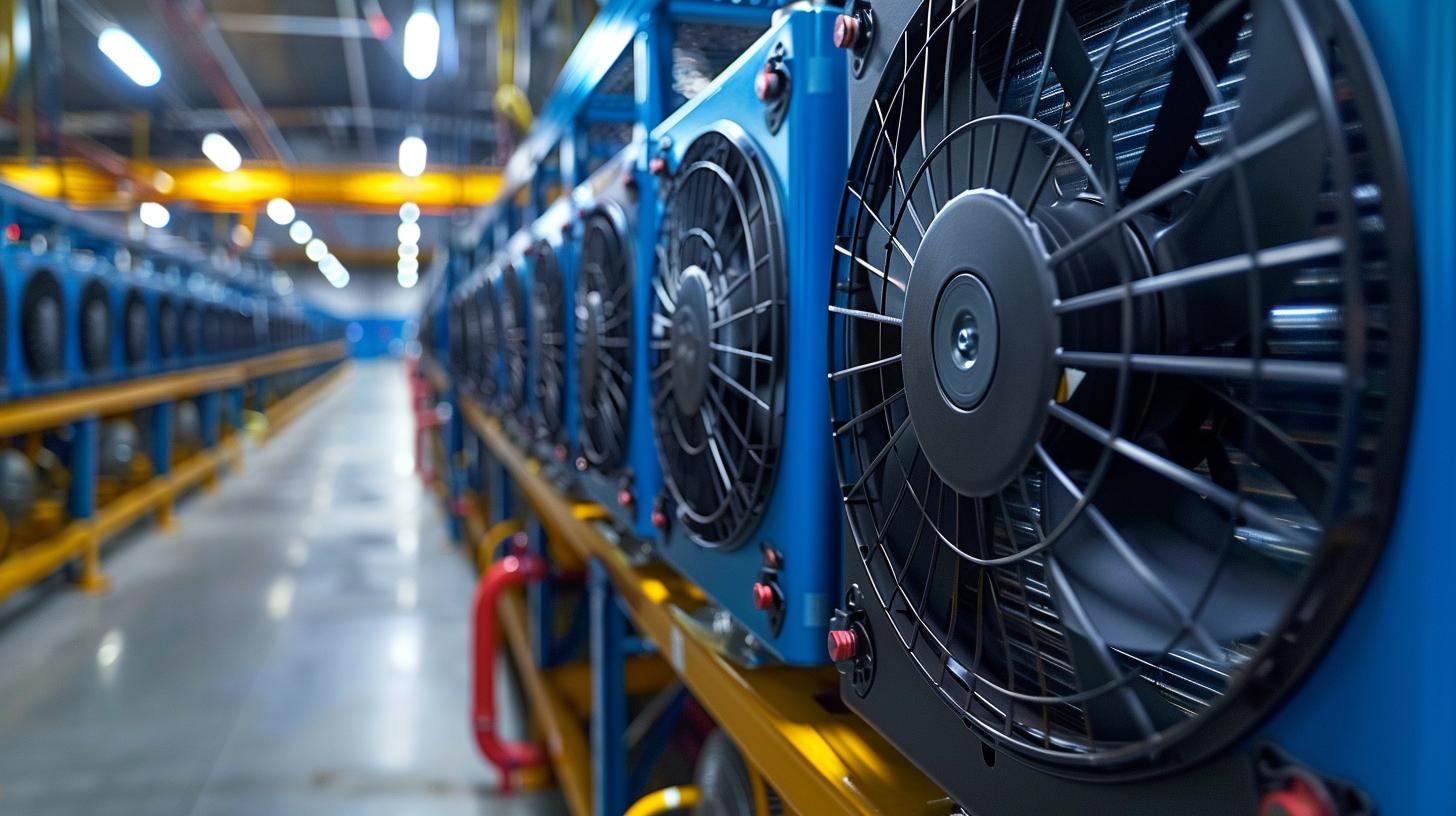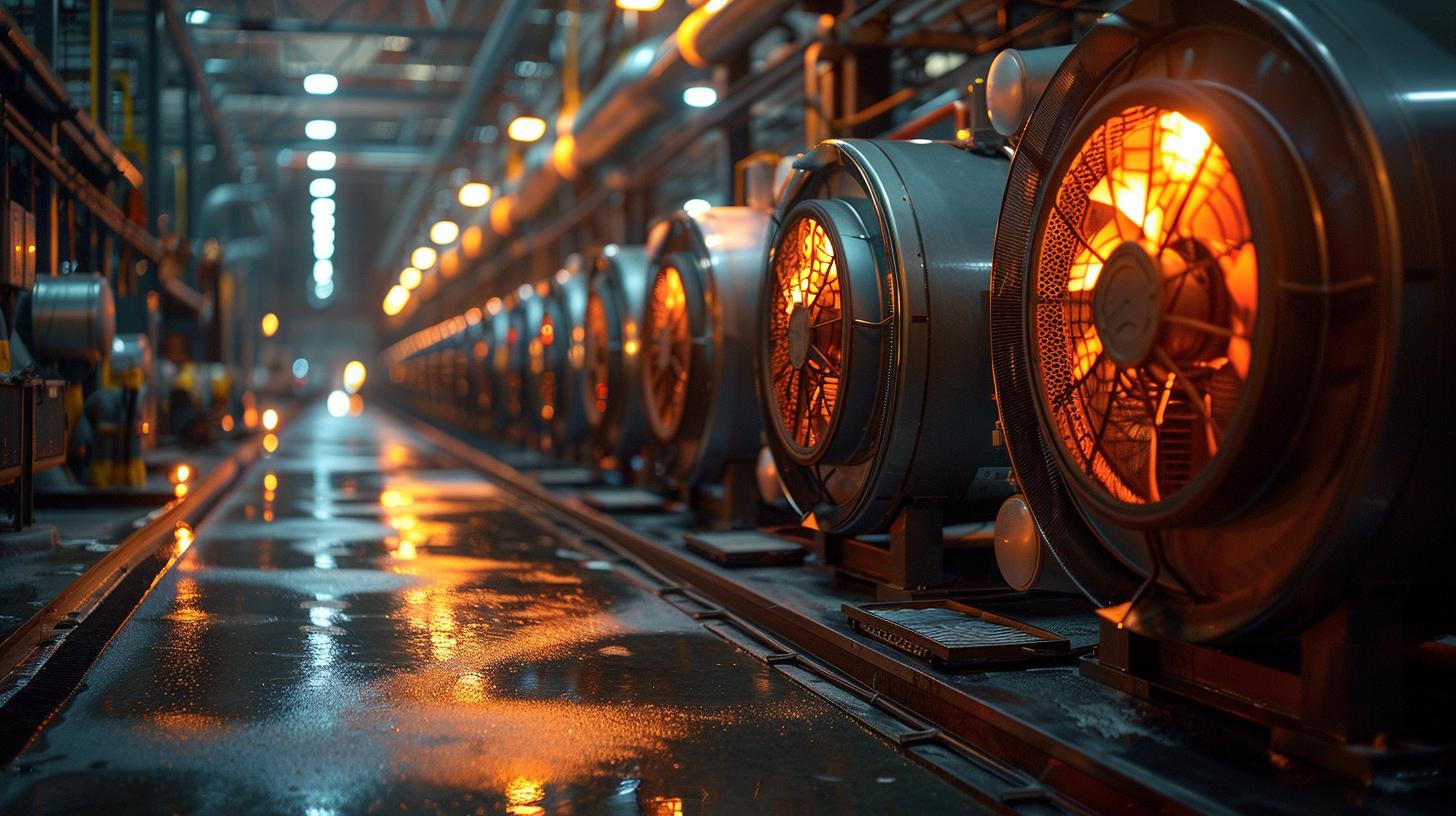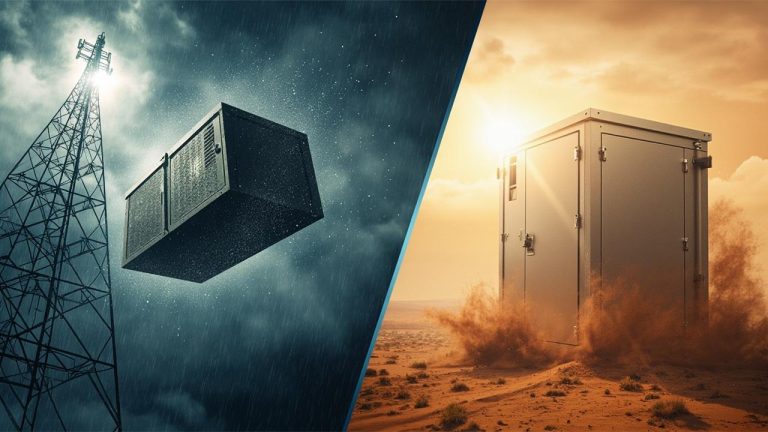Staying ahead in the world of digital currency necessitates having a comprehensive understanding of cryptocurrency mining and an effective cryptocurrency mining maintenance plan. This process-deploying a network of computer systems to add transactions to the blockchain on behalf of the currency system-is a fundamental component of how cryptosystems work.
The importance of regular and ongoing maintenance in cryptocurrency mining cannot be overstated. Creating a detailed maintenance plan for your hardware is, therefore, not just beneficial but essential for anyone serious about cryptomining.
Cryptocurrency mining is an intricate process that functions as both a consensus mechanism (achieving agreement on the state of the blockchain) and an issuance mechanism (distributing new tokens). Mining involves keeping track of transactions in chunks called blocks and adding them to the blockchain: this ensures security, fidelity, and fairness within the Ethereum or Bitcoin networks, among others. Without robust maintenance practices in place, these systems can break down due to overuse or poor upkeep-sometimes beyond repair.
Understanding that proper data airflow plays a significant role in maintaining crypto mining systems adds another layer to our discussion about proactive care for vital equipment. In essence, data airflow interacts with crypto mining systems by ensuring that electronic elements stay cool during operation while also preventing damage from static electricity shocks caused by dry air conditions.
The link between data airflow and apparatus longevity underlines why it’s integral to incorporate provisions for ongoing maintenance-particularly involving airflow-in your overall crypto mining strategy. As we navigate through this article, we’ll explore critical aspects necessary to develop an effective plan that includes routine checks on data airflow while actually implementing such a plan successfully over time.
The Value of Maintenance in Cryptocurrency Mining
Cryptocurrency mining is a procedure that can be profitable to those who invest not only their money but time and effort. Of all the tasks necessary to favorably monetize this activity, the upkeep of mining equipment is often underestimated and sometimes even overlooked entirely. As such, it has become essential to underline the surging significance of formulating and adhering to an effective cryptocurrency mining maintenance plan.
- Extension of lifespan: Almost every piece of hardware used in cryptocurrency mining has an inherent life expectancy that can be significantly extended through regular maintenance. Regular cleaning, for instance, removes dust and other particles that can exert strain on components over time. Proper manipulation also reduces wear and tear – preserving the hardware for extended use. Further, implementing measures like regulating temperature or ensuring ventilation extends the lifespan by minimizing damage caused by overheating.
- Enhanced performance: A routinely maintained system consistently performs at its optimal level thereby driving up output and profits. For example, replacing aged parts or performing timely updates enhance overall efficiency.
- Profitability assurance: Cryptocurrency markets fluctuate constantly; thus ensuring your hardware is in top condition allows you to take advantage of these swings to optimize profit gain while reducing downtime due to malfunctioning equipment.
It’s crucial, however, not just having a cryptocurrency mining maintenance plan but adhering consistently to it as well. The advantages highlighted above serve as evidence proving how proper upkeep impacts profitability directly – via enhanced output – and indirectly – through reduction in repair or replacement costs-.
Maintenance isn’t just about averting disaster but more so enhancing functionality regularly – keeping these systems operating smoothly means better productivity overall. Thus when considering stepping into the world of crypto mining remember: beyond direct costs linked with setting up a working mine lies an ongoing expense related with running one efficiently, which involves consistent maintenance among others things – notably adherence to a viable cryptocurrency mining maintenance plan.
Understanding the Role of Data AirFlow in Cryptocurrency Mining
The Interaction of Data Airflow With Mining Systems
Unfamiliar to many, data airflow significantly influences the productivity and efficiency of cryptocurrency mining systems. As these systems continuously work in complicated computations to extract new digital coins, they can generate substantial amounts of heat. Left unchecked, this buildup can damage equipment and deteriorate functioning speed.
This is where data airflow becomes particularly important. Acting as a cooling agent, regulated data airflow dissipates heat from the mining hardware, maintaining an optimal temperature that allows them to function at their best potential.
The Importance of Maintaining Data Airflow
Adhering to a cryptocurrency mining maintenance plan that integrates proper data airflow mechanisms is thus critical for any miner who aims for long-lasting and efficient operations. An inconsistent or deficient data airflow not only opens up the risk for overheating but also results in increased energy consumption and lower hash rates-the measure of the processing power in bitcoin network-thus making mining less profitable.

Quite simply put, maintaining proper data airflow doesn’t just save your equipment from possible physical damage but it also ensures that you get the most out of your investment by enhancing overall performance.
Addressing Common Issues Affecting Data Airflow
Despite its vital role, managing data airflow isn’t always straightforward and problem-free. Some common issues miners run into include poor ventilation due to confined spaces or malfunctions in cooling units, blending hot exhaust air with cold intake air leading to unpredictable temperature fluctuations; even dust accumulation can greatly impair a system’s ability to circulate air efficiently.
A well-thought-out cryptocurrency mining maintenance plan should be prepared ahead with strategies targeted at resolving such problems promptly. This may involve conducting regular inspections for dust build-up or foreseeing adequate spacing between equipment during setup to ensure free movement of air.
Equipments generating more heat could be identified and strategically placed closer to cooling units, while old and inefficient coolers could be replaced with more advanced and suitable ones. Being proactive in addressing these potential issues is vital in ensuring mining equipment runs smoothly and profitably over time.
Beyond Repair
Real-Life Scenarios of Neglected Maintenance
The instances where cryptocurrency miners learn the hard way about the significance of good, continuous maintenance are abundant in number. For instance, some have experienced complete breakdowns of their hardware due to poor or no attention paid to cooling systems and data airflows.
The absence of a proper cryptocurrency mining maintenance plan often leads to these critical components becoming clogged with dust, overheating, and eventually malfunctioning. Such neglect destroys the efficiency needed for competitive mining against other peers in the network.
In extreme cases partially uncooled equipment led to spontaneous combustion, causing massive harm that extended beyond repair. In other instances, miners have found their GPUs or ASICs burning out faster due to not maintaining a consistent ambient temperature in their farming environment – another crucial part of a sound maintenance strategy that is often overlooked; this expedited wear and tear massively decreases the expected lifespan of the hardware involved.
The Financial Implications
From a financial perspective, dismissing adequate maintenance for mining rigs comes with severe implications too. Breakdowns often translate into pricey repairs or expensive replacements. Moreover, operational downtimes can drastically impact profits; every moment a miner’s hardware is non-functional is time wasted not earning cryptocurrencies. Depending on market conditions and electricity costs at any given moment, such downtimes can equate to substantial revenue loss for miners.
Furthermore, regularly replacing burnt out parts divisively affects return on investment (ROI). Cryptocurrency mining operations require significant initial capital investments in technology and resources; frequent replacements drastically slow down when said investment breaks even or turns profitable due to continued unexpected additional expenditures not accounted for initially.
Avoidable Costs: Time & Money Saved With Regular Maintenance
Considerable sums can be saved by implementing an effective cryptocurrency mining maintenance plan (including provisions for regular data airflow checks), rather than simply reacting as issues arise. Investing ‘upfront’ in high-quality and resistant hardware, combined with regular inspections to ensure systems are working optimally, can prolong the lifespan of your assets substantially. It’s a preventive measure that reaps long-term benefits.
One should not forget the value of time either in this context; prevention saves ample time dedicated to troubleshooting equipment failures or arranging the purchase and installation of new parts. In an industry as volatile and fast-paced as cryptocurrency mining, where opportunities arise quickly but can be equally fleeting, time saved on maintenance issues is effectively money gained.
Every ounce of energy and every moment spent in actual mining – rather than problem-solving – empowers miners a step closer toward their financial objectives. Weekly reviews of hardware functionality and performance metrics could prevent catastrophic failures that put a halt to operations altogether for extended periods.
Formulating an Effective Cryptocurrency Mining Maintenance Plan
A thorough and effective cryptocurrency mining maintenance plan is the jumping-off point for ensuring the durability of your mining hardware. The foremost aspect to consider in this plan is timing. Establishing regular, scheduled check-ups will assist in catching any issues before they escalate into significant problems that compromise the integrity of the system. This includes inspecting equipment for signs of wear, checking cooling systems, evaluating power supplies, and assessing data airflow.

Another crucial component is cleanliness. Cryptocurrency mining can generate substantial dust build-up which inevitably impacts performance. Regular cleaning cycles should be built into your maintenance plan to keep the system running smoothly.
Lastly and importantly, always have a contingency plan. In instances where damage may be unavoidable or an unexpected failure occurs, having a back-up system in place will reduce downtime and secure continuity in your crypto mining activities.
Including Data AirFlow Maintenance
When considering a comprehensive cryptocurrency mining maintenance plan, it is often easy to overlook how well-supported data flow impacts overall effectiveness and efficiency. Consistent air movement helps regulate heat produced by these systems thus ensuring longevity of sensitive equipment components.
For efficient data airflow management, installing coolers or fans at appropriate locations around your setup can significantly regulate temperature levels during intense operations. Furthermore, organizing cables properly ensures unobstructed flows that enhance performance minimising risks associated with overheating.
Lastly, investing in professional monitoring solutions would aid in maintaining regular analytics on airflow patterns helping you detect anomalies early providing time to implement remedial actions.
Implementing and Adhering to the Maintenance Plan
After you’ve formulated a solid cryptocurrency mining maintenance plan, ensure diligence in its implementation and adherence over time – consistency being paramount here.
- Maintain an organized record system logging all check-ups performed, findings observed through inspections along with any repairs conducted.
- Be disciplined in meeting your scheduled cleaning, checking and backup systems assessments as per your set routine.
- Lastly, take care of minor glitches as soon as they appear without sacrificing the bigger maintenance picture. Prompt diagnosis and fixing of small problems can save you from substantial future troubles.
Conclusion
The importance of proper and ongoing maintenance in cryptocurrency mining cannot be underestimated. The influence it has on the performance, longevity, and overall profitability of the mining equipment is immense. Particularly when considering the significant role of data airflow in optimizing mining operations, an efficient cryptocurrency mining maintenance plan becomes a non-negotiable aspect of this digital endeavor.
In a rapidly changing landscape as cryptocurrency mining where return on investment hinges upon seamless operation and opportunistic capturing of market variations, any downtime caused by hardware failure or improper data airflow could lead to substantial financial losses. To prevent such loss-causing conditions a well-crafted cryptocurrency mining maintenance plan is essential.
This plan, incorporating regular checks and servicing not only ensures smooth running but also works proactively in identifying potential functional issues before they escalate into major complications leading to irreversible damage.
Finally, remember that the ultimate goal in this digitally intricate field is to achieve stability while maximizing returns. A commitment to comprehensive maintenance creates an environment conducive for such stability while minimizing chances of unexpected disruptions. As we navigate through the exciting world of cryptocurrency mining, stressing on priority for maintaining your hardware’s health can never be understated – after all preservation today is better than repair tomorrow.
| Aspect | Role in Cryptocurrency Mining |
|---|---|
| Maintenance | Ensures longevity, enhances performance and maintains profitable operation of mining hardware. |
| Data Airflow | Sustains optimal operational efficiency through thermal management. |
| Cryptocurrency Mining Maintenance Plan | Helps identify issues preemptively and contributes toward sustained profitable operations. |
References and Further Reading
As we conclude, the resounding theme that emerges from our discussion is the indispensable role of ongoing maintenance in cryptocurrency mining. Ongoing maintenance, coupled with an astute understanding of data airflow dynamics, ensures your expensive mining hardware continues to perform efficiently, extends its overall lifespan and secures your investment return in this volatile digital currency arena. Neglecting these critical factors can lead to substantial financial loss due to irreparable damage and productivity downtime.
A robust cryptocurrency mining maintenance plan is no longer a luxury but an absolute necessity for cryptocurrency miners who aim for long-term sustainability in their operations. Preventive measures incorporated within the plan extend beyond occasional checks and quick fixes.

It involves regular, systematic inspections of hardware components’, software updates and crucially, maintaining optimal data airflow configurations. The latter is often overlooked despite its critical function in preserving equipment’s efficiency and mitigating overheating problems, which could prove catastrophic if unchecked.
In summary, by investing time and resources into a cryptocurrency mining maintenance plan now greatly outweigh confronting highly probable disastrous outcomes later on due to neglecting it. Undertaking an effective preventive maintenance program bolsters system stability and maximizes returns simultaneously.
Remember, longevity and prosperity in the world of cryptocurrency are dreams only realized by those brave enough to first navigate through the realities of meticulous maintenance protocols and strict adherence to bewitching airflows dancing inside their mining equipment. These are non-negotiable keys in unlocking sustainable success amidst unpredictable currents in the virtual seascape of cryptocurrency.
Frequently Asked Questions
How Do You Take Care of a Crypto Miner?
Taking care of a crypto miner involves adequate maintenance and vigilance. It requires regular checks to ensure it is working properly, which includes monitoring its temperature as overheating can cause damage. A good cooling system is essential to prevent your miner from overworking or even crashing.
Additionally, cleanliness matters because dust accumulation can be detrimental to the miner’s performance. Lastly, keeping software up-to-date with the latest updates and security patches helps in maintaining optimum working conditions.
Why Is Crypto Mining No Longer Profitable?
Crypto mining is no longer profitable for several reasons. Firstly, competition has increased tremendously as more players are attracted by the potential returns from mining digital currencies such as Bitcoin and Ethereum.
Secondly, the cost of electricity used by heavy-duty accompanying hardware has skyrocketed while the rewards for mining have decreased due to halving events that reduces new coins’ emission rate. Lastly, the price fluctuation of cryptocurrencies can render mining unprofitable if prices drop significantly.
How Long Does a Crypto Miner Last?
The lifespan of a crypto miner greatly depends on how well it is maintained and operated. Generally speaking, top-quality ASIC (Application-Specific Integrated Circuit) miners can last between 2-3 years if operated in ideal conditions: stable power supply, low humidity and a cool environment without dust pollution.
However, operating them constantly under maximum load or in unfavorable conditions could shorten their life expectancy considerably.
Is Crypto Mining Bad for Health?
There may be indirect health risks related to crypto mining due to poorly ventilated spaces bringing exposure to heat produced by miners and noise pollution from running expensive rigs round-the-clock at full capacity; this might lead to sleep disturbances or stress-related health issues over time but no evidence exists currently that links directly performing crypto operations with harmful effects on human health.
Is It Worth Buying a Crypto Miner?
Whether buying a crypto miner is worth it depends largely on individual circumstances including financial resources available for investment, technical expertise in handling blockchain technology, current prices of cryptocurrencies being mined and future market predictions among others; mining can yield satisfactory returns when done effectively but also potentially steep financial loss if factors such as falling cryptocurrency prices, increases in mining difficulty or fluctuations in electricity costs are negligible.
Can You Make a Living Mining Crypto?
It is possible to make a living from crypto mining albeit increasingly challenging due to market saturation and rising operation costs; serious miners often invest significant amounts into the best hardware and also economies where electricity is cheap while amateurs might join mining pools that combine processing powers of multiple participants to solve cryptographic tasks faster which eventually share rewards based on each’s contribution.
What Do Crypto Miners Want?
Crypto miners generally seek for profitable returns on their investment. They require a stable internet connection, access to affordable power supplies, high-quality hardware, adaptive software and favorable regulatory environment. They are interested in securing new coins before others do by solving complicated arithmetic puzzles and adding verified transactions onto blockchain thus creating new blocks rewarded with freshly minted cryptocurrencies.
What Are Crypto Miners Actually Doing?
Cryptocurrency miners essentially play integral role in decentralized networks by providing computational power needed for confirming transactions thereby securing the stability, security and trustworthiness of digital currencies; they engage in specialized calculations designed to find a specific number known as ‘nonce’ — upon successful discovery, nonce serves as proof-of-work allowing them to add new block onto the public ledger (blockchain) effectively earning themselves newly generated tokens or transaction fees as reward.




